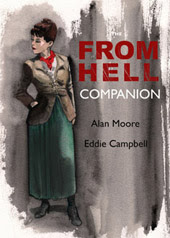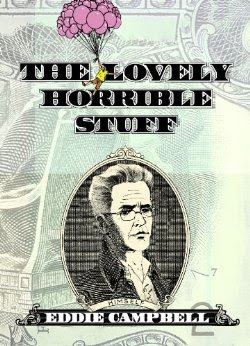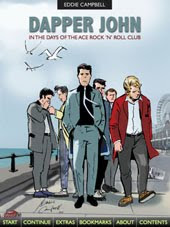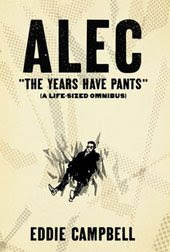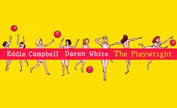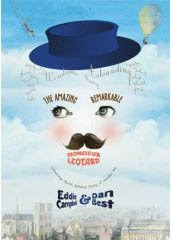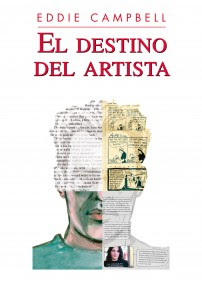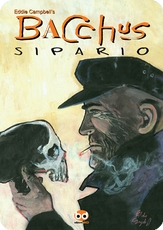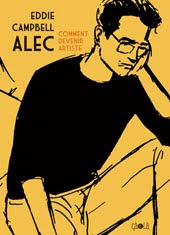FROM HELL 14/6
(Articulating pictorial space, part 2.)

An artist plots his way through pictorial space by putting one thing partially behind another. But what if there's no 'nother thing to put a thing behind? Or any receding straight lines with which to lead the eye through a readable perspective? This page of Alan Moore's From Hell script caused a murmur around my studio when we first read it. It required a 3-dimensional hole in the middle of the air some distance away, in the sky high over the sea, with blood issuing from it both toward and away from 'us'. I had the help of the upper and lower panels in establishing an exaggerated dramatic depth of field as well as locating 'up' and 'down'. To an extent you can depend on the white sky at the top of the second tier being read as continuation of the white sky in the first, even though we have now apparently moved some distance upwards, and the three horizons in the second tier being more or less continuous even though the altitude introduces curvature. Pictorial space on a multi-panelled page embraces simultaneous contradictions.
FROM HELL CHAPTER 14. PAGE 6. (673 words)
PANEL 1
NOW A FIVE PANEL PAGE. THERE IS ONE BIG PANEL ON THE TOP TIER, THREE SMALLER PANELS ON THE MIDDLE TIER AND THEN ONE BIG PANEL ON THE BOTTTOM TIER. IN THIS FIRST PANEL WE ARE LOOKING UPWARDS INTO THE BLINDING LIGHT OF THE BRIGHT MEDITERRANEAN SUN THAT HANGS ABOVE US IN A CLEAR SKY, WITH NO MORE THAN A FEW RAGGED AND RAPIDLY EVAPORATING WISPS OF CLOUD AROUND THE EDGES. THE LIGHT IS BLINDING. FLAPPING IN THE FOREGROUND AND BEYOND WE SEE A NUMBER OF SEA-GULLS, REMINISCENT OF THE DUCKS WE SAW ERUPTING IN A FLAPPING CLOUD IN THE LAST PANEL OF PAGE THREE IN CHAPTER TWO. HERE, HOWEVER, WE CAN NO LONGER SEE ANY SIGN OF THE BARGE, OR OF THE YOUNG WILLIAM GULL. WE ARE HIGH IN THE HOT SKY ABOVE THE AEGEAN SEA. IT IS 1888. THE GULLS FLAP AND WHEEL AGAINST THE BLINDING DISC OF THE SUN, UP ABOVE US.
CAPTION: Light. Ecstasy. the sun.
CAPTION: Where am I now?
PANEL 2.
IN THIS FIRST SMALL PANEL ON THE SECOND TIER IT IS AS IF WE HAVE SHIFTED OUR GAZE AWAY FROM THE SUN TO LOOK DOWN BENEATH US. FAR BELOW, WE CAN SEE THE GLITTERING AEGEAN, WITH ONLY GULLS AND A FEW WISPS OF CLOUD BETWEEN US AND THE SHINING WATERS FAR BELOW. UP TO ONE CORNER WE CAN MAYBE SEE PART OF THE COASTLINE OF ONE OF THE ISLANDS ENTERING THE PANEL, WITH A LINE OF SURF BOILING AND RIPPLING AROUND IT. FAR BELOW US, WE CAN SEE A COUPLE OF SMALL GREEK FISHING BOATS MAKING THEIR WAY ACROSS THE STILL AND SHIMMERING WAYTERS, LEAVING V-SHAPED WAKES BEHIND.
CAPTION: A knowledge comes to me that I am high above the glittering Aegean, and it is no longer 1896.
CAPTION: It is instead the year of my achievement. It is 1888.
PANEL 3
SAME SHOT AS LAST PANEL, LOOKING DOWN ON THE AEGEAN WITH THE FISHING BOATS MOVED ON ONLY A LITTLE SINCE OUR LAST IMAGE, AND THE GULLS LIKEWISE WHIRLING INTO NEW POSITIONS. UP IN THE FOREGROUND, HANGING IN EMPTY SPACE IN FRONT OF US, SOMETHING QUITE SMALL IS STARTING TO ERUPT OUT OF EMPTY AIR, AS IF FROM A POINT. IT'S SORT OF LIKE A SMALL AND SYMMETRICAL SQUIRTING OR SPLATTERING OF A DARK AND VISCOUS LIQUID, JUST ERUPTING FROM A POINT OUT OF NOWHERE, THE THICK LIQUID GOBBETS ALMOST LIKE THE RADIATING PETALS OF A TERRIBLE FLOWER.
CAPTION: I hover on the brink of form, incohate and ethereal, filled with a fierce, exultant joy I must make manifest.
CAPTION: I concentrate my being to a single, bloody point.
PANEL 4.
SAME SHOT, WITH THE BOATS BELOW AND THE GULLS MOVED ON ONLY A LITTLE. UP IN THE FOREGROUND, THE SPLATTERING POINT OF BLOOD HAS NOW GROWN MUCH BIGGER, BLOSSOMING INTO A HUGE AND EXTRAORDINARILY LIQUID ALIEN FLOWER OF MOVING, FLOWING BLOOD. WEIRDLY BEAUTIFUL AND SYMMETRICAL, LIKE A THREE DIMENSIONAL RORSCHACH BLOT, IT HANGS SUSPENDED IN THE SKY ABOVE THE AEGEAN, A VISIONARY MIRACLE HANGING THERE IN DEFIANCE OF GRAVITY AND PHYSICS. ITS SHAPE , THOUGH SYMMETRICAL, IS MONSTROUS AND IRREGULAR, GOBBETS AND BEADS OF THE THICK AND GLEAMING PLASMA HANG SUSPENDED IN THIN AIR ABOUT THE EDGES OF THE CENTRAL BLOSSOMING FORM, WHICH IS BOTH GORGEOUS AND APPALLING.
CAPTION: In rapture I explode, a scarlet cloudburst.
CAPTION: Fluids from Buck's row and Mitre square and Miller's Court, rich and sublime they flower against the blue Aegean sky.
PANEL 5.
NOW, IN THIS FINAL WIDE PANEL, WE ARE DOWN ON THE DECK OF ONE OF THE NINETEENTH-CENTURY GREEK FISHING BOATS BELOW. IT'S RAINING BLOOD. THE SAILORS GAPE UP AT IT IN FEAR AND ALARM; IN STARK BEWILDERMENT. THE HEAVY CRIMSON DOWNPOUR SPATTERS OFF THE DECK AND TRICKLES DOWN THE ARMS AND FACES OF THE HORROR-STRICKEN SAILORS. IT STAINS THEIR SHIRTS AND RUNS INTO THEIR FRIGHTENED STARING EYES. IT PUDDLES THERE IN THE UNEVEN TIMBERS OF THE DECK.
CAPTION: A pelting thunderhead of murder, here I sign my year of panics with appalling miracle.
Labels: composition, From hell scripts-2





